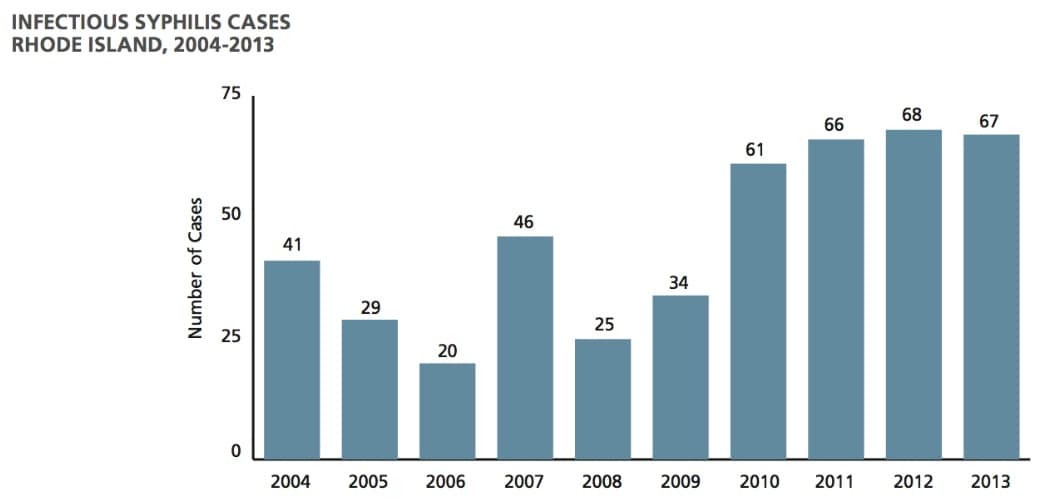Advertisement
New Normal In Age Of Hookup Apps? Rhode Island Rises In Syphilis, Gonorrhea, HIV

By Marina Renton
CommonHealth intern
The numbers are striking: Recent double-digit rises around the country in long-familiar sexually transmitted diseases — gonorrhea, HIV, even the old scourge of syphilis.
Perhaps even more striking is what Thomas Bertrand of the Rhode Island Department of Health said recently about the rising numbers on Here & Now: "I would not call it a crisis, I'd call it a new normal right now, and we need to push against it."
Last month, the Rhode Island Department of Health put out a press release with its data from 2013 to 2014: Reported cases of infectious syphilis increased 79 percent, gonorrhea cases increased 30 percent, and newly diagnosed HIV cases increased 33 percent.
While these figures are dramatic, particularly the increase in syphilis, it’s important to remember that year-to-year changes aren’t always the best data to look at, said Bertrand, who is chief of the office of HIV, STDs, Viral Hepatitis, and Tuberculosis for the state Department of Health. It’s better to examine a period of five to 10 years, he says.
But those numbers don't look good either: Since 2009, Rhode Island, along with the rest of the country, has seen increases in chlamydia, gonorrhea and syphilis, Bertrand said in a phone interview. “We mirror the national trends in general.”
“The acceleration or the increase may be a little bit steeper in Rhode Island than the rest of the country, but just a little bit,” he added.
Can swiping right lead to STDs?
The Rhode Island Department of Health’s statement mentions the use of hookup apps as a “high-risk behavior” that could be associated with the increase in STDs. However: “We don’t have data to say that the use of social media or the people who use it are more infectious or transmitting disease more than people who don’t,” Bertrand said.
But the apps do add to tracking problems: When people use social media such as Tinder and Grindr to arrange hookups, the encounter can be casual and brief, so people don’t share much information, Bertrand said. So, when someone is diagnosed with an STD, he or she might not be able to provide contact information for his or her sexual partners, making it harder to curb the spread of the disease.
Given the use of social media to arrange sexual encounters, there is opportunity for the health department to move online, Bertrand said.
“Most of the work we’ve been doing [recently] has been Internet-based," he says, "getting information out there that is easy to understand and very practical.”
What else might be at work?
The CDC reported a 10 percent increase in syphilis from 2012 to 2013, but between 2009 and 2013 there was a 24 percent increase in cases of syphilis nationally, Bertrand says. Gay and bisexual men are at particular risk for the infection, the CDC wrote in a fact sheet on the 2012 to 2013 changes.
Rhode Island health officials have also observed that gay and bisexual men seem to be at higher risk for syphilis and, at the end of 2014, the health department implemented a social marketing initiative to encourage gay and bisexual men to get screened, Bertrand says.
More screening?
The Rhode Island Department of Health suggests an additional reason for the increase in reported cases of STDs: better testing.
When syphilis is in its early stages, it’s possible to miss the symptoms, Bertrand says. The primary stage manifests as a sore, or chancre, that might be hidden and painless enough that someone doesn’t know it’s there. With more regular screenings, a doctor is able to catch the disease before it progresses enough to have serious complications, he says.
Syphilis is commonly transmitted through oral sex, as well as anal and vaginal, Bertrand said, so “we need to…educate people that some STDs, like syphilis, can be transmitted through oral sex.”
Societal shifts might also play a role in the recent rise in STDs.
“I’m finding anecdotally that younger people are choosing to self-identify in many different ways sexually,” Bertrand says. “High school students who self-identify as part of the LGBTQ population…have higher risk factors. So that’s a group that we want to make sure that we’re working with.”
STDs seem not to scare young people as much as they used to, Bertrand added. While many of them are treatable, they can still have long-term consequences, such as reproductive health problems, he added.
“Society is evolving in so many ways, whether it be the Internet or contraception or advances in society’s acceptance of people who don’t identify as straight or heterosexual,” Bertrand says. “I don’t think there’s one single magic bullet [to halt the increase in STDs]…we have to be very sensitive to people’s needs and behavior and…see if we can work with them.”
Numbers in perspective
Bertrand also notes that because Rhode Island is such a small state, a large percent increase in the number of cases might not point to an immediate crisis. For example, a change from two to three is a 50 percent increase, but the numbers are still objectively small.
“We have small numbers sometimes, and so we’ll see an increase and the percentage increase looks really large, but if there were larger numbers there wouldn’t be as much of an increase,” Bertrand says.
Again, the longer-term trends are key. But a short-term spike can serve as a red flag: The 2013 to 2014 jump was “bigger than something we would have predicted,” he says.
So are these recent rises just blips or possibly trends of concern?
One thing seems certain: The world is changing quickly, from technology to sexual identities, Bertrand tells Here & Now. "Our traditional tools for trying to keep STD rates down are not as useful as they once were, and I just think we need to be more progressive."